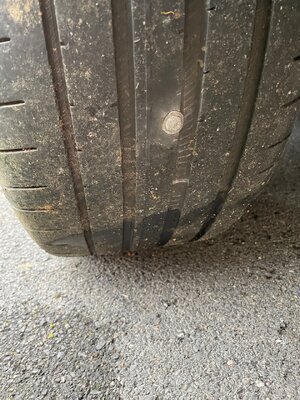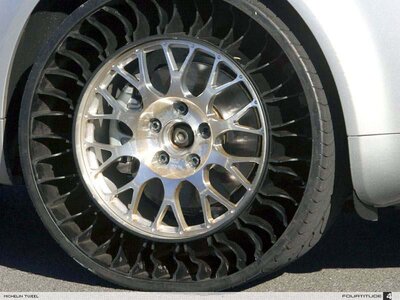Many threads on the forum make mention of tyre life and the advice to change regularly on a time scale rather than wear basis.
I've just had a really strange issue related to tyres:
My van is 4 years old and the tyres are of similar age. Tread wear is probably about half - at a guess we've traveled around 15,000 miles - much in Europe during the warmer months.
We've been away over Christmas visiting family which meant we were not in the van for two nights/days. Pressures were checked before leaving home.
Returning to the CL after family visit I immediately noticed the nearside tyre was deflated. It wasn't flat since supported by the steadies!!!
I changed it for the spare as might be expected.
What intrigued me was if the tyre was "on its way" whilst towing then why did my Tyrepal not warn me. If the deflation only took place after arriving on site then that would have been extremely unlucky to pick up a puncture in a hundred yards of towing.
I didn't spend a great deal of time examining the deflated tyre - it was raining and said tyre was rather muddy.
Traveling back home the Tyrepal behaved quite normally which suggests the damage did indeed occur during the last yards of the tow and whilst on the CL.
Today I washed the wheel and tyre and closely examined it for the culprit. Expecting a nail or similar I was surprised to find no damage at all. Neither cracking nor a foreign body.
Next step was to try inflating the tyre. I reached around 15 psi which feels reasonably firm standing on the tyre and stopped the pump. Silence except for a slight hissing. I removed the pump and in so doing pushed the tyre valve to one side - immediately a rush of escaping air!
Bit of a long winded story so apologies for that but I would never normally check the valve, just tread and sidewalls.
Couple of things spring to mind apart from the obvious "Don't forget to wiggle your valve"
1. Pushing the valve to one side allowed a rush of air to escape. How fortunate was I for this not to have happened whilst towing. (Especially since the last mile or so is a narrow(ish) road that is also a rural bus route! Nearside wheel change means stopped away from verge so bus/tractor or car would need to wait - how much pressure would that be!)
2. Thank goodness I moved my spare to the front gas locker when the van was new. To have had to crawl around muddy ground and extract the tyre and wheel from beneath the van would have been - well, words fail me!. Working with a clean brand new spare made life so much more pleasant.
3. Although never used in anger before thank goodness for my Kojack. Small block of wood on the ground and jack secured - safe and quite quick lifting of van.
I'll check with the garage when I pick the wheel up what happened to the valve.
I've just had a really strange issue related to tyres:
My van is 4 years old and the tyres are of similar age. Tread wear is probably about half - at a guess we've traveled around 15,000 miles - much in Europe during the warmer months.
We've been away over Christmas visiting family which meant we were not in the van for two nights/days. Pressures were checked before leaving home.
Returning to the CL after family visit I immediately noticed the nearside tyre was deflated. It wasn't flat since supported by the steadies!!!
I changed it for the spare as might be expected.
What intrigued me was if the tyre was "on its way" whilst towing then why did my Tyrepal not warn me. If the deflation only took place after arriving on site then that would have been extremely unlucky to pick up a puncture in a hundred yards of towing.
I didn't spend a great deal of time examining the deflated tyre - it was raining and said tyre was rather muddy.
Traveling back home the Tyrepal behaved quite normally which suggests the damage did indeed occur during the last yards of the tow and whilst on the CL.
Today I washed the wheel and tyre and closely examined it for the culprit. Expecting a nail or similar I was surprised to find no damage at all. Neither cracking nor a foreign body.
Next step was to try inflating the tyre. I reached around 15 psi which feels reasonably firm standing on the tyre and stopped the pump. Silence except for a slight hissing. I removed the pump and in so doing pushed the tyre valve to one side - immediately a rush of escaping air!
Bit of a long winded story so apologies for that but I would never normally check the valve, just tread and sidewalls.
Couple of things spring to mind apart from the obvious "Don't forget to wiggle your valve"
1. Pushing the valve to one side allowed a rush of air to escape. How fortunate was I for this not to have happened whilst towing. (Especially since the last mile or so is a narrow(ish) road that is also a rural bus route! Nearside wheel change means stopped away from verge so bus/tractor or car would need to wait - how much pressure would that be!)
2. Thank goodness I moved my spare to the front gas locker when the van was new. To have had to crawl around muddy ground and extract the tyre and wheel from beneath the van would have been - well, words fail me!. Working with a clean brand new spare made life so much more pleasant.
3. Although never used in anger before thank goodness for my Kojack. Small block of wood on the ground and jack secured - safe and quite quick lifting of van.
I'll check with the garage when I pick the wheel up what happened to the valve.



